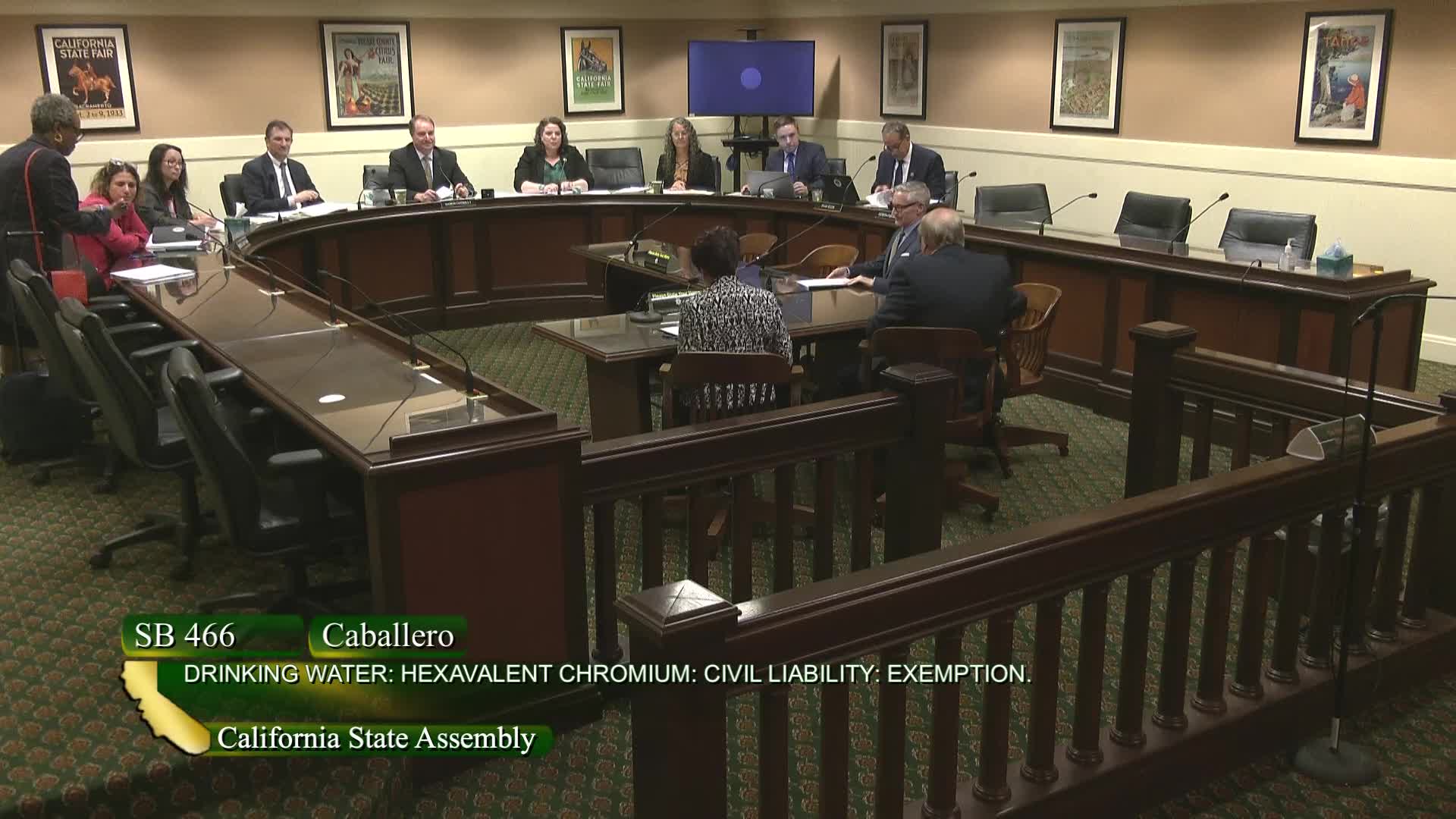Senator Caballero sponsors SB 466 to shield water districts from Chromium 6 lawsuits
July 01, 2025 | California State Assembly, House, Legislative, California
This article was created by AI summarizing key points discussed. AI makes mistakes, so for full details and context, please refer to the video of the full meeting. Please report any errors so we can fix them. Report an error »

In a recent meeting of the California State Assembly's Environmental Safety and Toxic Materials Committee, discussions centered around Senate Bill 466 (SB 466), which aims to provide legal protections for public water systems dealing with naturally occurring chromium 6 in drinking water. This legislation is particularly significant as it addresses the challenges faced by small communities, such as Los Banos, which are grappling with stringent new regulations on chromium levels.
The bill proposes to shield water providers from civil lawsuits as long as they are actively implementing a compliance plan approved by the State Water Board. This is crucial because the new maximum contaminant level (MCL) for chromium 6 has been set at 10 parts per billion, a significant reduction from previous standards. Many water systems, including those in disadvantaged communities, are struggling to meet this new requirement due to the high costs associated with necessary infrastructure upgrades, which can exceed millions of dollars.
Mayor Michael Amabile of Los Banos highlighted the financial burden on small cities, noting that compliance could cost over $65 million for his community alone. He emphasized that these costs would ultimately fall on local ratepayers, making the legal protections offered by SB 466 essential for allowing water providers to focus on compliance rather than litigation.
Scott Burrett, representing the Coachella Valley Water District, echoed these concerns, stating that the anticipated costs for compliance could reach $400 million, with rates expected to double for residents. He stressed the importance of the bill in enabling water agencies to prioritize compliance efforts without the distraction of costly lawsuits.
The committee also discussed the ongoing scientific debate regarding the health risks associated with low-level exposure to chromium 6, which remains a contentious issue. While the State Water Board has established the new MCL, the exact health implications of long-term exposure are still under investigation.
Despite the support for SB 466, some committee members raised concerns about the potential for a blanket exemption from civil liability, particularly for individuals who may suffer harm due to chromium exposure. The bill does not prevent the Attorney General from pursuing legal action against non-compliant water agencies, but it does limit individual lawsuits during the compliance period.
As the committee moves forward, the discussions around SB 466 highlight the delicate balance between ensuring safe drinking water and protecting public water systems from litigation. The bill is seen as a temporary measure to facilitate compliance while addressing the financial realities faced by many communities. The anticipated timeline for compliance varies, with some systems expected to meet the new standards by 2026, while others may require additional time.
In conclusion, the committee's deliberations on SB 466 underscore the urgent need for effective solutions to manage chromium 6 levels in drinking water, particularly in vulnerable communities. The outcome of this legislation will have significant implications for public health and the financial stability of water systems across California.
The bill proposes to shield water providers from civil lawsuits as long as they are actively implementing a compliance plan approved by the State Water Board. This is crucial because the new maximum contaminant level (MCL) for chromium 6 has been set at 10 parts per billion, a significant reduction from previous standards. Many water systems, including those in disadvantaged communities, are struggling to meet this new requirement due to the high costs associated with necessary infrastructure upgrades, which can exceed millions of dollars.
Mayor Michael Amabile of Los Banos highlighted the financial burden on small cities, noting that compliance could cost over $65 million for his community alone. He emphasized that these costs would ultimately fall on local ratepayers, making the legal protections offered by SB 466 essential for allowing water providers to focus on compliance rather than litigation.
Scott Burrett, representing the Coachella Valley Water District, echoed these concerns, stating that the anticipated costs for compliance could reach $400 million, with rates expected to double for residents. He stressed the importance of the bill in enabling water agencies to prioritize compliance efforts without the distraction of costly lawsuits.
The committee also discussed the ongoing scientific debate regarding the health risks associated with low-level exposure to chromium 6, which remains a contentious issue. While the State Water Board has established the new MCL, the exact health implications of long-term exposure are still under investigation.
Despite the support for SB 466, some committee members raised concerns about the potential for a blanket exemption from civil liability, particularly for individuals who may suffer harm due to chromium exposure. The bill does not prevent the Attorney General from pursuing legal action against non-compliant water agencies, but it does limit individual lawsuits during the compliance period.
As the committee moves forward, the discussions around SB 466 highlight the delicate balance between ensuring safe drinking water and protecting public water systems from litigation. The bill is seen as a temporary measure to facilitate compliance while addressing the financial realities faced by many communities. The anticipated timeline for compliance varies, with some systems expected to meet the new standards by 2026, while others may require additional time.
In conclusion, the committee's deliberations on SB 466 underscore the urgent need for effective solutions to manage chromium 6 levels in drinking water, particularly in vulnerable communities. The outcome of this legislation will have significant implications for public health and the financial stability of water systems across California.
View full meeting
This article is based on a recent meeting—watch the full video and explore the complete transcript for deeper insights into the discussion.
View full meeting
